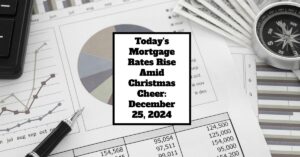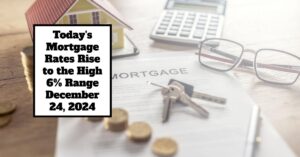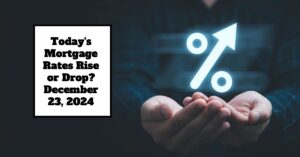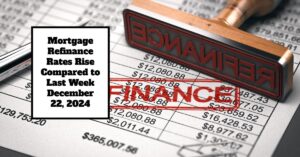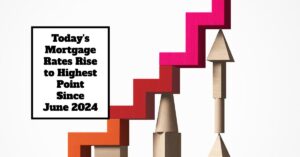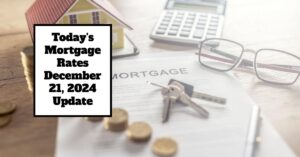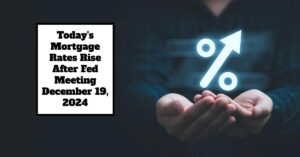If you're considering buying a new home or refinancing your current mortgage, understanding today's mortgage rates is crucial. The cost of borrowing can significantly impact your finances, and staying informed helps you make better decisions. As of December 26, 2024, mortgage rates have seen some fluctuations, and it’s essential to grasp how these rates work, what affects them, and where they stand today.
Today's Mortgage Rates for Homebuyers: December 26, 2024
Key Takeaways
| Takeaway | Details |
|---|---|
| Current Rates | The 30-year fixed mortgage rate is 6.73%, while the 15-year fixed mortgage rate is 6.14%. |
| Trends | Recent increases in rates suggest a potential for continued elevation through 2025. |
| Types of Mortgages | Familiarize yourself with fixed vs. adjustable rates to choose what fits your financial situation best. |
| Factors Influencing Rates | Economic conditions, your credit score, and down payment size can dictate your mortgage rate. |
| Refinancing Rates | For refinancing, the 30-year fixed rate stands at 6.86%, showing it's slightly higher than purchase rates. |
Understanding Today’s Mortgage Rates
Mortgage rates on December 26, 2024, indicate a small rise after a few weeks of decreases. According to the latest data from Zillow and other credible sources, here are the current national averages for mortgage rates:
| Type of Mortgage | Current Rate |
|---|---|
| 30-Year Fixed | 6.73% |
| 20-Year Fixed | 6.78% |
| 15-Year Fixed | 6.14% |
| 5/1 Adjustable-Rate Mortgage | 6.81% |
| 7/1 Adjustable-Rate Mortgage | 6.75% |
| 30-Year VA | 6.19% |
| 15-Year VA | 5.57% |
| 5/1 VA | 6.38% |
Mortgage Refinance Rates Today
When looking at refinancing options, today’s mortgage refinance rates are as follows:
| Type of Refinance | Current Rate |
|---|---|
| 30-Year Fixed | 6.86% |
| 20-Year Fixed | 6.58% |
| 15-Year Fixed | 6.07% |
| 5/1 Adjustable-Rate Mortgage | 6.14% |
| 7/1 Adjustable-Rate Mortgage | 6.64% |
| 30-Year VA | 6.19% |
| 15-Year VA | 5.96% |
| 5/1 VA | 5.79% |
These statistics provide a snapshot of where rates currently stand and indicate trends toward a potential rise as we move further into 2025.
How Do Mortgage Rates Work?
To grasp the concept of mortgage rates, it's important to note that these rates represent a fee for borrowing money, expressed as a percentage. There are mainly two types of mortgage rates:
| Type | Description |
|---|---|
| Fixed-Rate Mortgages | A fixed-rate mortgage maintains the same interest rate for the entire loan duration. For example, if you secure a 30-year mortgage at a rate of 6%, you will continue to pay 6% for the full 30 years unless you refinance or sell the home. |
| Adjustable-Rate Mortgages (ARMs) | These mortgages have a fixed initial rate for a certain number of years, after which the rate adjusts periodically based on market conditions. For instance, a 5/1 ARM offers a fixed rate for the first five years before adjusting each year thereafter. |
Over time, mortgage payments are structured such that in the early years, a larger portion goes toward interest, gradually shifting more toward paying off the principal.
Determining Mortgage Rates
Several factors influence mortgage rates, including:
| Factor | Description |
|---|---|
| Credit Score | Higher credit scores typically yield lower mortgage rates. Lenders view borrowers with better scores as less risky. |
| Down Payment | The size of your down payment can also affect your rate — higher down payments typically lead to lower rates. |
| Debt-to-Income (DTI) Ratio | This ratio, which compares your monthly debt payments to your gross monthly income, is essential. Lower DTI ratios indicate that your income can comfortably cover your debt obligations. |
On a broader level, the economy plays a vital role. If the economy is doing well (for instance, low unemployment), mortgage rates may rise to maintain a balance in the market. Conversely, during economic downturns, rates may drop to stimulate borrowing and spending.
Exploring 30-Year vs. 15-Year Fixed Mortgage Rates
The two most prevalent types of fixed-rate mortgages are the 30-year and 15-year options. Each has its distinctive advantages and drawbacks:
| Mortgage Type | Advantages | Disadvantages |
|---|---|---|
| 30-Year Fixed Mortgage | – Lower monthly payments make it more affordable month-to-month. | – Higher interest rates lead to more paid interest over time. |
| 15-Year Fixed Mortgage | – Often lower interest rates mean you pay significantly less in total interest. | – Higher monthly payments can strain budgeting. |
Consequently, choosing between a 30-year and a 15-year fixed mortgage often boils down to your financial situation and goals.
Recent Trends in Mortgage Rates
Looking at the current data, it’s clear that mortgage rates have fluctuated in recent months. Customers should pay close attention to these trends as they will influence both purchasing power and monthly payments. The rise in rates can be attributed to recent decisions by the Federal Reserve regarding interest rates.
At a recent Federal Reserve meeting, Fed Chair Jerome Powell indicated that the central bank plans to cut the federal funds rate only twice in 2025 rather than the four cuts previously anticipated. This change signifies a continual tightening in monetary policy, which likely means mortgage rates will trend higher in the short to medium term.
Implications for Homebuyers
The implications for homebuyers are significant. As mortgage rates increase, the overall cost of purchasing a home also rises. Potential buyers might find their borrowing capacity impacted, which can affect their home search. For instance, if you previously qualified for a loan that allowed for a $300,000 purchase, an increase in mortgage rates could lower that amount, thereby reducing your options in the housing market.
Many buyers who would have qualified for a lower rate may now need to consider additional options, such as larger down payments or potentially looking for less expensive homes. Alternative financing tools, such as adjustable-rate mortgages, can also be appealing in a rising-rate environment, but they come with their own risks.
Refinancing Considerations
For those looking into refinancing, the current higher rates may lead to challenging decisions. Borrowers whose existing loans were secured at lower rates might hesitate to refinance into a higher rate, even if they could benefit from other factors like loan consolidation or cash-out refinancing.
Potential refinancers should evaluate their long-term goals and consider whether their current interest rate reflects the true value of their home or the benefits of refinancing, such as cashing out for home improvements or reducing monthly obligations.
Summary
Today's mortgage rates reflect a pivotal moment in the financial landscape for homeowners and prospective buyers. As you navigate the complexities of purchasing or refinancing a home, understanding how these rates work will empower your decision-making process. Though rates are currently on the rise, knowing the factors that influence them can help you strategize effectively for your mortgage needs.
Work with Norada in 2025, Your Trusted Source for
Turnkey Investment Properties
Discover high-quality, ready-to-rent properties designed to deliver consistent returns.
Contact us today to expand your real estate portfolio with confidence.
Contact our investment counselors (No Obligation):
(800) 611-3060
Recommended Read:
- NAR Predicts 6% Mortgage Rates in 2025 Will Boost Housing Market
- Mortgage Rates Predictions for 2025: Expert Forecast
- Half of Recent Home Buyers Got Mortgage Rates Below 5%
- Mortgage Rates Need to Drop by 2% Before Buying Spree Begins
- Will Mortgage Rates Ever Be 3% Again: Future Outlook
- Mortgage Rates Predictions for Next 2 Years
- Mortgage Rate Predictions for Next 5 Years
- Mortgage Rate Predictions for 2025: Expert Forecast
- Prediction: Interest Rates Falling Below 6% Will Explode the Housing Market
- Mortgage Rate Predictions: Why 2% and 3% Rates are Out of Reach
- How Lower Mortgage Rates Can Save You Thousands?
- How to Get a Low Mortgage Interest Rate?
- Will Mortgage Rates Ever Be 4% Again?

